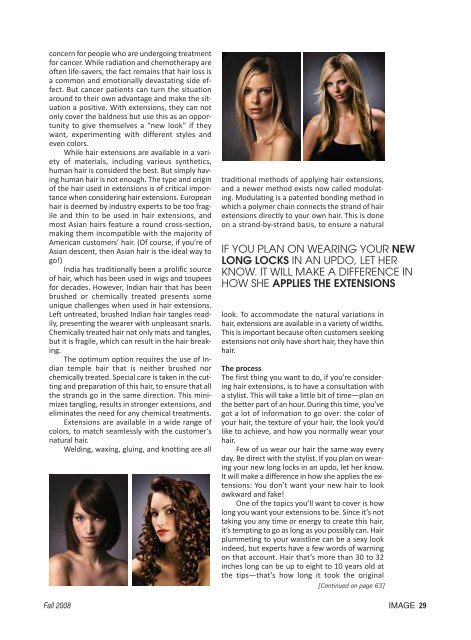TEEN KUTZ
TEEN KUTZ
TEEN KUTZ
Create successful ePaper yourself
Turn your PDF publications into a flip-book with our unique Google optimized e-Paper software.
concern for people who are undergoing treatment<br />
for cancer. While radiation and chemotherapy are<br />
often life-savers, the fact remains that hair loss is<br />
a common and emotionally devastating side effect.<br />
But cancer patients can turn the situation<br />
around to their own advantage and make the situation<br />
a positive. With extensions, they can not<br />
only cover the baldness but use this as an opportunity<br />
to give themselves a “new look” if they<br />
want, experimenting with different styles and<br />
even colors.<br />
While hair extensions are available in a variety<br />
of materials, including various synthetics,<br />
human hair is considerd the best. But simply having<br />
human hair is not enough. The type and origin<br />
of the hair used in extensions is of critical importance<br />
when considering hair extensions. European<br />
hair is deemed by industry experts to be too fragile<br />
and thin to be used in hair extensions, and<br />
most Asian hairs feature a round cross-section,<br />
making them incompatible with the majority of<br />
American customers’ hair. (Of course, if you’re of<br />
Asian descent, then Asian hair is the ideal way to<br />
go!)<br />
India has traditionally been a prolific source<br />
of hair, which has been used in wigs and toupees<br />
for decades. However, Indian hair that has been<br />
brushed or chemically treated presents some<br />
unique challenges when used in hair extensions.<br />
Left untreated, brushed Indian hair tangles readily,<br />
presenting the wearer with unpleasant snarls.<br />
Chemically treated hair not only mats and tangles,<br />
but it is fragile, which can result in the hair breaking.<br />
The optimum option requires the use of Indian<br />
temple hair that is neither brushed nor<br />
chemically treated. Special care is taken in the cutting<br />
and preparation of this hair, to ensure that all<br />
the strands go in the same direction. This minimizes<br />
tangling, results in stronger extensions, and<br />
eliminates the need for any chemical treatments.<br />
Extensions are available in a wide range of<br />
colors, to match seamlessly with the customer’s<br />
natural hair.<br />
Welding, waxing, gluing, and knotting are all<br />
traditional methods of applying hair extensions,<br />
and a newer method exists now called modulating.<br />
Modulating is a patented bonding method in<br />
which a polymer chain connects the strand of hair<br />
extensions directly to your own hair. This is done<br />
on a strand-by-strand basis, to ensure a natural<br />
IF YOU PLAN ON WEARING YOUR NEW<br />
LONG LOCKS IN AN UPDO, LET HER<br />
KNOW. IT WILL MAKE A DIFFERENCE IN<br />
HOW SHE APPLIES THE EXTENSIONS<br />
look. To accommodate the natural variations in<br />
hair, extensions are available in a variety of widths.<br />
This is important because often customers seeking<br />
extensions not only have short hair, they have thin<br />
hair.<br />
The process<br />
The first thing you want to do, if you’re considering<br />
hair extensions, is to have a consultation with<br />
a stylist. This will take a little bit of time—plan on<br />
the better part of an hour. During this time, you’ve<br />
got a lot of information to go over: the color of<br />
your hair, the texture of your hair, the look you’d<br />
like to achieve, and how you normally wear your<br />
hair.<br />
Few of us wear our hair the same way every<br />
day. Be direct with the stylist. If you plan on wearing<br />
your new long locks in an updo, let her know.<br />
It will make a difference in how she applies the extensions:<br />
You don’t want your new hair to look<br />
awkward and fake!<br />
One of the topics you’ll want to cover is how<br />
long you want your extensions to be. Since it’s not<br />
taking you any time or energy to create this hair,<br />
it’s tempting to go as long as you possibly can. Hair<br />
plummeting to your waistline can be a sexy look<br />
indeed, but experts have a few words of warning<br />
on that account. Hair that’s more than 30 to 32<br />
inches long can be up to eight to 10 years old at<br />
the tips—that’s how long it took the original<br />
[Continued on page 63]<br />
Fall 2008 IMAGE 29


